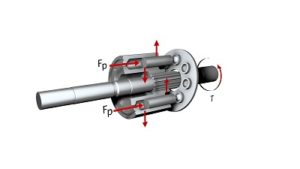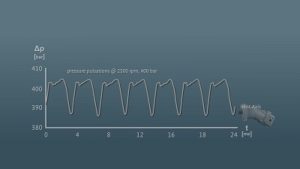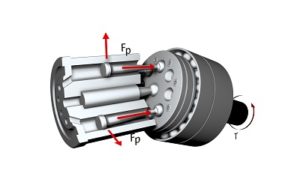Heightened concerns over climate change and global warming are key reasons for the growing interest in zero-emission vehicles. Battery-electric mobile machines, while still mainly in the prototype stage, may require hydraulic-pumps and variable-speed drives to evolve to suit future applications.

Typical forces in an axial-piston pump can lead to issues in battery-powered equipment.
Hydraulic pumps are high-performance components. However, according to engineers at Bucher Hydraulics, Klettgau, Germany, they have some fundamental flaws that highlight a considerable need for improvement in the face of new demands.
Technically mature and well-proven hydraulic pumps and motors work to their full potential in mobile machinery, traditionally designed and engineered for use in combination with diesel engines. They were invented for such applications, have been continuously improved over decades and are suitably efficient in this combination today. Having said that, these mature solutions are clearly reaching their limits in new applications involving electrification of the drive train, particularly where battery-powered machines are concerned. This is evident in almost all the application-critical factors: from starting behavior and installation envelope to noise level and efficiency.
Battery capacity is expensive and it therefore needs to be used efficiently, but the extent to which this can be achieved depends largely on individual components in a system. Recent electrification projects clearly confirm the high efficiency of electric drives. The efficiency of hydraulic systems is lagging behind in comparison, and is not ideal for these applications. Using a simple, low-cost pump results in high power losses at the expense of the battery. Valuable battery capacity is needed just to make up for the power losses, and it is inevitably converted into useless heat.
Power losses
The efficiency of a hydraulic pump and its power losses directly affect costs and emissions. Consider the example of a pump with an 80 cc/rev displacement operating at 250 bar pressure and 1,500 rpm. Pump efficiency ηp = 0.85 and power losses at the shaft = 8.8 kW.
The power lost at the hydraulic pump must also be supplied by the electric motor, which means electrical efficiency ηe (e-motor + inverter) = 0.92, which equates to a power loss = 9.5 kW at the incoming electrical supply. After a running time of 1,000 hours, this equals 9,500 kWh.
Using the German Environment Agency’s CO2 emissions factor for 2017, this gives an emission of 5,102 kg CO2 just to make up for inherent losses resulting from inefficiencies in the motor/pump system. In addition to the increased emissions, compensating for the power loss at the hydraulic pump will, of course, also have an impact on costs: 1,000 hours @ $0.16/kWh = $1,520.
High noise levels
Due to their particular design, axial piston pumps generate considerable noise. The pulsating displacement of the hydraulic fluid, and the related alternating and widely fluctuating internal pump forces, result in housing vibrations that ultimately transmit to the entire machine. This causes a high noise level in the application.

High pulsations typical in axial-piston pumps result in problematic noise levels in electric-drive applications.
Although sound insulation can be added as a secondary measure, that is always associated with extra work, the need for a larger installation space, and additional costs. In industrial settings this is sometimes unavoidable, but it is almost unthinkable in the mobile-hydraulics sector due to the limited space availability.
When hydraulic pumps are used with diesel engines as originally intended, the problems of physical pulsation are barely noticeable. This changes fundamentally in applications with quiet electric motors, where the characteristic loudness becomes prominent in an extremely disagreeable way and is completely rejected by end users. Instead, they demand the lowest possible noise emission over a wide range of speeds and pressures.
Speed and pressure
A related concern is how the pump performs at low speeds. That is because at high pressures, to prevent high wear due to mixed friction, variable-speed pumps must not fall below a certain minimum speed. This is particularly evident when positioning heavy loads, where only a low flow rate at high pressure will guarantee precision movements.
In this case, speed is an important criterion for establishing lubricating films. However, due to the minimum speed limit (not less than 1,000 rpm), the pump delivers too much oil and the excess has to be discharged via a bypass. At high pressure, this results in large losses. These losses also have to be made up for by the battery: some of its capacity is simply being converted into useless heat. Last but not least, the high pressure of 350 bar that is required in mobile machines cannot be attained with simple external gear pumps.
The situation is similarly critical when the pump operates as a motor. When energy efficiency is one of the most important issues, the overall efficiency of the hydraulic drive unit does not score highly due to its inadequate energy recovery. When recovering potential energy (for example, a raised weight) and transferring it to an energy storage device, the losses are simply too high — which ultimately means that too little energy returns to the battery.
Motor starting behavior

The large, non-compensated forces in bent-axis motors need to be absorbed by extra-large ball or roller bearings. This increases space requirements and makes integration more difficult.
Another negative feature that make the use of hydraulic drives more challenging is the starting behavior of hydraulic motors, especially those based on a swashplate design: the motor is initially subject to loads and static friction before it suddenly starts to move. This process presents application difficulties, and it has a damaging effect when, for example, a hoist winch is being used to jog-position an awkward load. In addition, operation at low speeds is subjected to superimposed torque pulsations. This, in turn, can lead to oscillations in susceptible machines and thus make secondary measures necessary.
Last but not least, the substantial installation space that is needed is a drawback: large, non-compensated forces in bent-axis motors can only be absorbed by extra-large ball or roller bearings. This increases the space required in the machine, so integration is less straightforward.
All in all, there is an urgent need to improve hydraulic pumps and motors in terms of their efficiency, noise generation, installation envelope and variable-speed capabilities. The demands placed on mobile machinery — which are already high — will only increase in the future.
Bucher Hydraulics
www.bucherhydraulics.com
Filed Under: Mobile Hydraulic Tips, Pumps & Motors